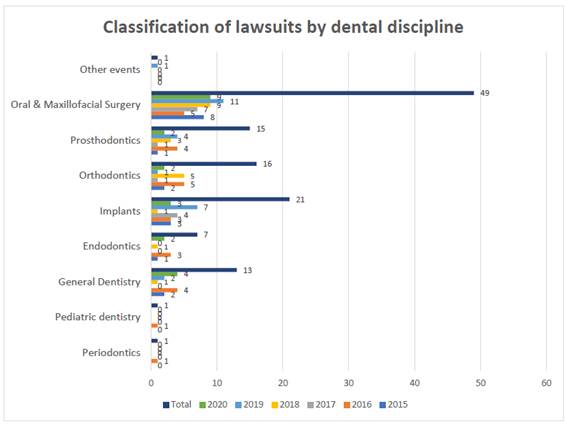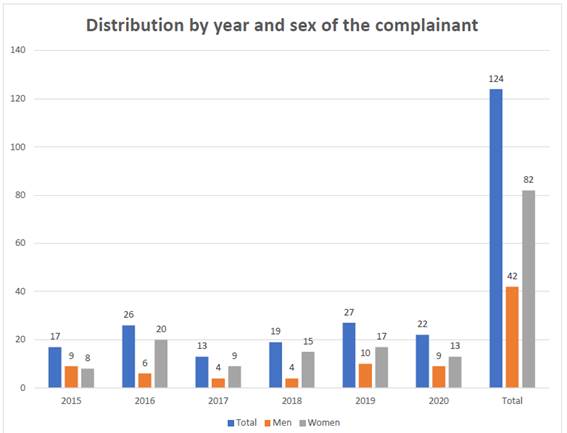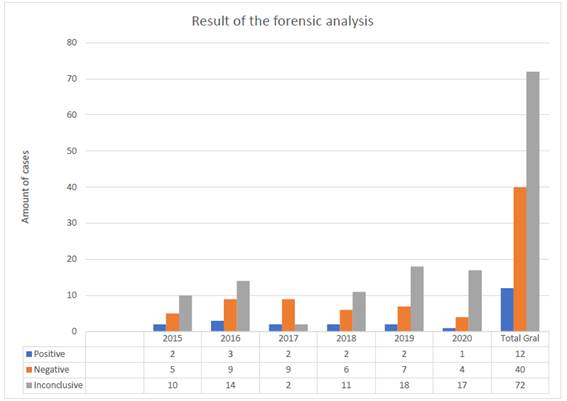Services on Demand
Journal
Article
Indicators
-
 Cited by SciELO
Cited by SciELO -
 Access statistics
Access statistics
Related links
-
 Similars in
SciELO
Similars in
SciELO
Share
Medicina Legal de Costa Rica
On-line version ISSN 2215-5287Print version ISSN 1409-0015
Med. leg. Costa Rica vol.38 n.2 Heredia Jul./Dec. 2021
Original Research
Dental malpractice lawsuits in Costa Rica: analysis of 124 cases in the period 2015-2020
1.Espec. Odontología Forense. Patología y Cirugía Oral. M.Sc.Administración de Servicios de Salud Sostenible. Profesor Facultad de Odontología Universidad de Costa Rica.Unidad de Odontología Forense, Departamento de Medicina Legal, Organismo de Investigación Judicial. Heredia, Costa Rica. ORCID ID: https://orcid.org/0000-0001-6478-5407
Introduction:
In Costa Rica, dental malpractice lawsuits (professional liability) are classified under the crime of culpable injuries according to the Criminal Code of Costa Rica. The purpose of this study is to describe the characteristics of all the claims analyzed by the Forensic Dentistry Unit of the Department of Legal Medicine in a period of six years (2015-2020).
Materials and methods:
A detailed review was carried out in the database of the Legal Medicine System (SIMEL) of the Legal Medicine Department of the Organismo de Investigación Judicial (Judicial Investigation Agency) of all the complaints of dental "malpractice" filed since January 1, 2015 to December 31, 2020. The information collected was tabulated in Excel and classified by year, related dental discipline, sex of the complainant and the result of the expert analysis.
Results:
The data analysis determined a total of 124 complaints, the disciplines with the highest percentages were oral and maxillofacial surgery (39.52%), dental implants (16.94%) and orthodontics (12.9%). More than two thirds (66.12%) of the complaints correspond to women and within the results of the forensic report 10% of the cases were positive, 32% negative and 58% inconclusive.
Conclusions:
The complete dental record is essential to be able to determine a causal link between the investigated facts and the results of a treatment; in this study more than 50% of the files where incomplete, invasive procedures such as oral surgery generate a greater possibility of lawsuits that could be avoided through proper management of risks and complications, adequate patient-caregiver communication, and management of treatment expectations.
Key words: Malpractice; dentistry; lawsuit; professional liability
Introduction
Dental professional liability lawsuits are commonly known as dental malpractice lawsuits, historically they have been overshadowed by complaints filed against medical professionals, both for the frequency and amounts of compensation. (1)
It is important to mention that complaints for dental treatments can involve serious situations such as fractures of the jaw or maxilla, less complex situations such as failure of fixed prostheses (bridges), crowns or dental implants to complaints of unadjusted dentures or aesthetic results that did not meet the expectations of the patients. (2)
One of the main problems when performing the analysis of complaints is the lack of elements available in clinical records, according to a study carried out in 2019 in Costa Rica related to dental clinical records, it was determined that 53.3% of physical records and 33.3% of digital systems presented incomplete clinical examination and data. (3)
A detailed file makes it possible to determine by means of evidence whether there is really a causal link between the facts investigated so that the judge has real criteria when it comes to dispensing justice. (4)
Dentistry has had great technical scientific advances in all specialties, every day there are more procedures that involve examinations in three dimensions such as tomography(5) and intraoral scans,(6) additionally aesthetic procedures that were previously rare are increasingly used such as facial fillers that have increased during the last 10 years (7) as well as facial cosmetic surgery performed by specialists in maxillofacial surgery. (8)
Materials and methods
A detailed review of each of the cases analyzed by the Forensic Dentistry Unit of the Department of Legal Medicine registered in the SIMEL database (Legal Medicine System) was carried out in a six-year period from January 1, 2015 to December 31, 2020.
A table was designed in Excel with the following characteristics of the cases: year, related discipline, sex of the complainant and result of the expert analysis that was classified as positive, negative and inconclusive. The classification of “inconclusive" was defined for those cases in which the lack of elements did not allow an objective criterion to be issued.
Results
Classification of lawsuits by dental discipline
In the six-year period analyzed, a total of 124 complaints were recorded, the average was 20 cases per year. When classified by discipline, the oral and maxillofacial surgery procedures were the ones with the highest number of processes (49) representing 39.52% of the total. The second area with the most complaints is Dental Implants with 16.94% (21 cases), followed by Orthodontic procedures with 16 cases (12.9%), Prosthodontics 12.1% (15 cases), General Dentistry 13 cases (10.48%), Endodontics 7 cases (5.64%); Pediatric dentistry, Periodontics and other events (falls) had 1 case each respectively (0.80%). SeeFigure 1.
Distribution by year and sex of the complainant
The data analysis revealed that the year 2019 presented the highest number of complaints (27 cases), followed by 2016 (26 cases), the year 2020 (22 cases), 2018 (19 cases), 2015 (17 cases) and the year 2017 was the year with the fewest complaints (13 cases).
Regarding to sex, the claims filed by women corresponded to 66.12% (82 cases) of the sample against 33.87% of men (42 cases) out of the total of 124 complaints, representing a ratio of 2 to 1 of cases of women and men. This behavior predominates in most years except for 2015 where the ratio is practically 1:1 as shown in Figure 2.
Result of the forensic analysis
As a result of the expert analysis carried out by the Forensic Dentistry Unit, it is observed that 12 cases were positive, representing 9.7% of the total, 40 cases were concluded as negative, that is 32.25% and finally 72 cases were classified as "inconclusive" that constitute 58.05% of all cases. SeeFigure 3.
Discussion
From the analysis of the data, it is observed that the behavior of complaints by discipline practically half of the cases are related to the most invasive procedures such as oral and maxillofacial surgery and dental implants. This behavior is similar in studies carried out in countries such as Chile,(9) Brazil,(10) and Spain. (11).
In relation to the result of the forensic analysis, less than 10% of the cases were positive, 32% are negative and 58% are inconclusive, which makes it indisputable that the absence of material evidence in the clinical file influences the results. From the expert analysis, these findings are compatible with those found in investigations carried out in Costa Rica regarding the performance of dental clinical records.(3)(12)
Regarding the sex of the complainants, women had a 2: 1 relationship with men, this percentage according to the literature may correspond to the fact that women use health services more frequently than men, these numbers are similar in studies carried out in countries such as Brazil, (10) Chile,(13) Mexico,(14) Italy,(15) and Spain. (16)
Within the complaints there is the classification of "other events", this was used specifically for the case of a user who suffered a precipitation (fall) after undergoing a surgical procedure.
It is important to mention that in many of the complaints filed, the lack of communication with the treating person is mentioned within the narrations and complaints, where no attempt was made to solve the main complaint or that the resolution time was not as expected, additionally another of the points described are the expectations prior to treatment that were not met, which highlights the importance of measuring the perception of user satisfaction.(17)
Conclusions
Within the legal processes for professional liability there is a common element that must be demonstrated to established if there is an omission of the duty of care and therefore determine if it is positive, this element is the so-called “causal link”.(4)
Regarding the expert report, it requires all the elements available in a clinical file to issue a scientific technical criterion in an objective manner, the lack of a complete clinical file makes it difficult to analyze cases and can leave both patients and professionals without tools for defense. Previous studies developed in Costa Rica have determined that the clinical record is not always carried out correctly.(12)
One of the facets to take into account within the professional practice of dentistry is the reduction of risks, since the literature establishes that practically half of the demands occur for events that are considered foreseeable and avoidable,(11)they must be previously explained and discussed during the realization of informed consent.
A good history and a good diagnosis, a detailed analysis of the main complaint and the expectations of the user are sine qua non requirements to achieve predictable treatments and reduce the possibility of lawsuits.
REFERENCES
1. Hapcook CP. Dental malpractice claims: Percentages and procedures. J Am Dent Assoc (Internet). 2006 Oct 1 (cited 2021 Aug 24);137(10):1444-5. Available from: http://jada.ada.org/article/S0002817714643518/fulltext [ Links ]
2. D’Cruz L. Risk management in clinical practice. Part 1. Introduction. Br Dent J. 2010 Jul 10;209(1):19-23. [ Links ]
3. Hernández Carazo D, Solano Romero K, Torres Guevara E, Trejos Cisneros JJ, Fernández Chaves JM. Determinación de la simbología más utilizada en expedientes odontológicos en Costa Rica en el año 2019 con fines de identificación de seres humanos. Med leg Costa Rica. 2020;37(1):179-91. [ Links ]
4. Loreto DBL, de Barros BÁC, Rosa GC da, de Oliveira RN, Rosing CK, Fernandes MM. Analysis of Dental Case Reports in the Context of Court Decisions: Causal Nexus and Aspects of Fault. J Forensic Sci. 2019;64(6):1693-7. [ Links ]
5. Buser D, Sennerby L, De Bruyn H. Modern implant dentistry based on osseointegration: 50 years of progress, current trends and open questions. Periodontol 2000. 2017;73(1):7-21. [ Links ]
6. K S. Progress in digital dentistry: The practical use of intraoral scanners. Dent Mater J (Internet). 2020 (cited 2021 Sep 5);39(1):52-6. Available from: https://pubmed.ncbi.nlm.nih.gov/31723066/ [ Links ]
7. Beauvais D, Ferneini EM. Complications and Litigation Associated With Injectable Facial Fillers: A Cross-Sectional Study. J Oral Maxillofac Surg (Internet). 2020;78(1):133-40. Available from: https://doi.org/10.1016/j.joms.2019.08.003 [ Links ]
8. Halepas S, Muchemi F, Higham ZL, Ferneini EM. The Past Decade in Courts, What Oral-Maxillofacial Surgery Should Know About Facial Cosmetic Surgery. J Oral Maxillofac Surg (Internet). 2021 (cited 2021 Aug 24);79:2021. Available from: https://doi.org/10.1016/j.joms.2021.04.007 [ Links ]
9. Villagra J, Zúñiga V, Macuada J, Marchant C, Muñoz C. Civil claims related to dental care in Chile according to court rulings 2011-2017. J Oral Res. 2020;9(5):363-71. [ Links ]
10. Zanin AA, Herrera LM, Melani RFH. Civil liability: characterization of the demand for lawsuits against dentists. Braz Oral Res (Internet). 2016 Aug 18 (cited 2021 Sep 2);30(1). Available from: http://www.scielo.br/j/bor/a/8njjNnScdJP6hmQmyZ8Qq5g/?lang=en [ Links ]
11. Perea-Pérez B, Labajo-González E, Santiago-Sáez A, Albarrán-Juan E, Villa-Vigil A. Analysis of 415 adverse events in dental practice in Spain from 2000 to 2010. Med Oral Patol Oral y Cir Bucal (Internet). 2014 Sep 1 (cited 2021 May 31 );19(5):e500-5. Available from: /pmc/articles/PMC4192575/ [ Links ]
12. Fernández Chaves JM. Utilidad de expedientes odontológicos disponibles en Costa Rica en el año 2018 para la identificación de víctimas de desastres según el protocolo de INTERPOL. Rev Med Leg Costa Rica (Internet). 2019 Mar (cited 2021 Mar 11);36(1):32-42. Available from: https://www.scielo.sa.cr/pdf/mlcr/v36n1/2215-5287-mlcr-36-01-32.pdf [ Links ]
13. Vega M J, Bedregal G P, Jadue H L, Delgado B I. Equidad de género en el acceso a la atención de salud en Chile. Rev Med Chil (Internet). 2003 Jun (cited 2021 Sep 2 );131(6):669-78. Available from: http://www.scielo.cl/scielo.php?script=sci_arttext & pid=S0034-98872003000600012 & lng=es & nrm=iso & tlng=es [ Links ]
14. González Barrón S, Jiménez Corona ME, Triana Estrada J, Ureña Ciret JL, García Hernández J, Carrillo Rocha J de D, et al. Recomendaciones para mejorar la práctica odontológica. Rev CONAMED, ISSN-e 1405-6704, Vol 8, No 1 (Enero-Marzo), 2003, págs 29-38 (Internet). 2003 (cited 2021 Sep 2);8(1):29-38. Available from: https://dialnet.unirioja.es/servlet/articulo?codigo=4052784 & info=resumen& idioma=ENG [ Links ]
15. Pinchi V, Varvara G, Pradella F, Focardi M, Donati M, Norelli G. Analysis of Professional Malpractice Claims in Implant Dentistry in Italy from Insurance Company Technical Reports, 2006 to 2010. Int J Oral Maxillofac Implants. 2014 Sep 19;29(5):1177-84. [ Links ]
16. Consejo Dentistas de España. 12. La salud bucodental en España la salud bucodental en España. 2015. 1-97p. [ Links ]
17. Fernández Chaves JM. Evaluación de la satisfacción de los usuarios con la atención recibida en la Unidad de Odontología Forense del Departamento de Medicina Legal del Organismo de Investigación Judicial en el segundo semestre del 2018. Med leg Costa Rica. 2020;37(1):162-78. [ Links ]











 text in
text in 






